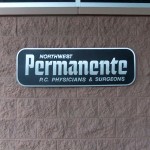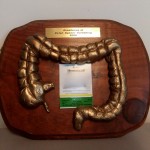When you go to see the doctor, how do they know (a) if you are due for any preventive health screenings like mammography or (b) if you have a chronic condition, if it is being monitored and managed? And actually, not just if it is being monitored or managed, but are you able to achieve your life goals with good health? And what about if you aren’t at the medical office, does your doctor know, are they aware of what is needed to keep you healthy?
My colleagues and are were at the Kaiser Permanente Medical Office in Tualatin, Oregon, to observe how this works in practice. What people may not know about electronic health records is that in and of themselves, many do not provide this function out of the box. They have typically been designed more to support the patient coming in in person for an immediate health care need, less to support the understanding of where a patient is in their health journey over time, or where an entire group of patients is at a time. And as we learned yesterday, even if an electronic health record does have this function, the technology is not enough to change the way health care is practiced.
Knowing, at every visit, and beyond
What we saw yesterday was remarkable in the era of health information technology. Patients could be seen for any condition, from a mole to foot pain, and within the course of the visit, it was known to not just the doctor but the entire team, if there was a care gap, such as a missed cholesterol test and this could be integrated into the conversation. And the “knowing” didn’t necessarily come from a pop-up alert in the middle of the discussion, it came from the Panel Support Tool (PST), proactively providing information before the visit even started, noted by the medical assistant, followed-up on by the physician, and ultimately (most importantly) by the patient.
In one case that I saw, this didn’t come from an alert or even a printout of care gaps, it came from the physician noticing that an order had been pended (parked, awaiting signature), by the medical assistant for a preventive health care test. This little cue brought the PST information, just a click away, and a conversation about preventing cancer for the patient. I hesitate to use the word “seamless,” but okay, I’ll use the word – it was seamless. It shows that what we as family practitioners trained to do, to think of a patient holistically in every interaction, can now be done.
Outside of the visit, things are still interesting. At Tualitin, physicians, mid-level providers such as physician assistants, and nurses take dedicated time out of their schedules to “know” their patient panel. Using techniques they’ve developed that are individualized to their practice and the members they serve, they use the tools at their disposal, from secure e-mail to telephone calls to letters, to reach out to patients based on the data that is clearly presented in group form, about which patients’ health can be improved with which interventions.
Not just programming code, leadership
We saw something else equally as important as the technology, and this is the value of going to where the patients get care – curious “awards” placed on walls and in medical office. One was the “(donut chain name) award for controlling HbA1c, with a donut mounted on a plaque.” One was a “Mammy award” for breast cancer screening. There was a “Golden colon” award for hemoccult testing.
Photos, click to enlarge
Also near to every clinician’s desk was their PST “report card,” showing where each panel is at with regard to closing care gaps, in comparison not just to other Kaiser Permanente physicians, but in comparison to all physicians in the United States. Some of these were heavily marked up, numbers circled, in preparation to change and close any care gaps that had emerged since the prior month.
What has happened here is the building of a culture by medical and nursing leaders about prevention and good health. Without the PST tool, which provides the ability to know, and the Electronic Health Record, which provides the ability to communicate and act, this could not be done. Without the support of culture, this could not be done.
If you come here, you will see that implementing an electronic health record is not enough to support high health care quality. People have to care about the way they use it to help people. I think that is as important a product as the technology itself.
Not just leadership, a relationship
The last thing we noticed about the ability to know is a greater understanding about the ability to “do,” and I think this is where this health system is gaining insights that have not existed before.
If it is possible to achieve 80 % – 90 % success across panel in breast cancer screening, for example, a patient would ask (as one did at the consumer partnership for eHealth last year), why not 100%? I think it’s pretty incredible in health care to have the confidence to ask this question, and answer it.
As we saw, physicians, mid-level providers, and nurses have a much deeper understanding of individual patients’ hurdles because they have now reached out to them specifically. This is part of what we saw. We also learned from Rob Unitan, MD, one of the progenitors of this system, that there is also a very powerful interaction between a patient having care gaps and being bonded to a physician practice. Patients that are not bonded (various reasons, from having multiple insurers to not having chosen a physician) have a much higher rate of care gaps. It is not clear how to get to 100 % for every patient yet (in all of health care), however there is very good understanding of the value of supporting a great relationship between a patient and a care team, not just in the science of medicine, but the art of medicine.
Getting back tot he power of leadership and feedback, one of the physicians I shadowed, Cathy Chester, MD, had the following articles attached to her wall/file cabinet: 1. Her PST report card 2. The on call schedule for physicians (always important) 3. Her “art of medicine” scores, and on the adjacent wall, photographs of her family and their accomplishments. I asked if the placement was a metaphor of how she judged herself as a quality physician.
The feedback that integrated patient- and population-centered systems provide is providing the ability of physicians to lead each other, and as I saw, the ability of physicians to lead themselves.
Today we are going to Orchards Medical Office, in Vancouver, Washington. With great thanks to the patients, nurses, clinicians at Kaiser Permanente Tualatin Medical Office.




6 Comments
Population care facilitated by HIT @ Kaiser, OR http://bit.ly/f3McOc [now if only other health plans could fig this out!]
RT @tedeytan: #kppopcare The ability to know – Population care faciltd by health info technology at Kaiser Tualitin, OR http://bit.ly/eyy1Fb
@TedEytan presents a great example of how health IT (#EMR) is being used to drive outcomes at the population level: http://bit.ly/hVgDSr
[…] The ability to know – Population care facilitated by health … […]
RT @tedeytan: #kppopcare The ability to know – Population care faciltd by health info technology at Kaiser Tualitin, OR http://bit.ly/eyy1Fb
RT @tedeytan: #kppopcare The ability to know – Population care faciltd by health info technology at Kaiser Tualitin, OR http://bit.ly/eyy1Fb